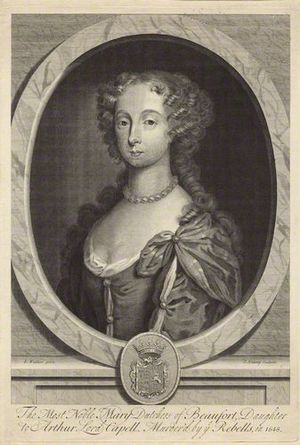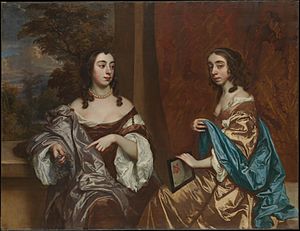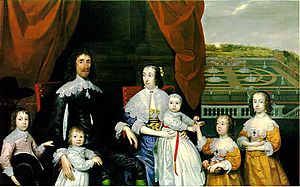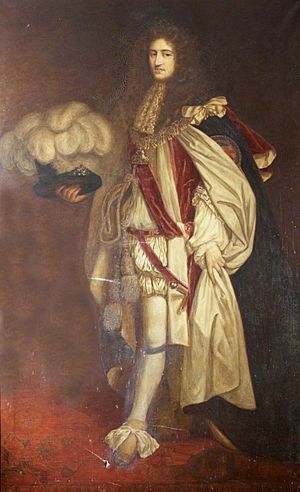Mary Somerset, Duchess of Beaufort (gardener) facts for kids
Quick facts for kids
The Duchess of Beaufort
|
|
|---|---|

Engraving by Joseph Nutting after Robert Walker
|
|
| Born | baptised 16 December 1630 Hadham Parva
|
| Died | 7 January 1715 (aged 84) |
| Resting place | St Michael and All Angels Church, Badminton |
| Nationality | English |
| Known for | 12 volume herbarium and introduction of exotic species to English gardening |
| Spouse(s) | |
| Children | 9, including Charles, Mary, Henrietta, and Anne |
| Scientific career | |
| Fields | Aristocrat and botanist |
| Influences |
|
Mary Somerset, Duchess of Beaufort (baptised 16 December 1630 – 7 January 1715) was an English noblewoman. She was also a talented gardener and botanist. She helped bring many new plants to English gardens. These included the Pelargonium zonale (a type of geranium) and Passiflora caerulea (blue passionflower). She was also known as Mary Seymour, Lady Beauchamp, and by her maiden name, Mary Capell.
Contents
Early Life and Family
Mary was born in Hadham Parva, Hertfordshire, England. She was baptised on December 16, 1630. Her father was Sir Arthur Capell, 1st Baron Capell of Hadham. Her mother was Elizabeth Morrison.
Life as a Noblewoman

Mary married her first husband, Henry Seymour, Lord Beauchamp, on June 28, 1648. They had one son and one daughter. Her husband was a Royalist, meaning he supported the King during the English Civil War. He was even put in prison.
After his death, Mary married Henry Somerset, 1st Duke of Beaufort, on August 17, 1657. He later became the 1st Duke of Beaufort. They had six children together.
Mary was known for being very organized. She made sure her household ran smoothly. She would check the house and gardens daily. She expected everyone to be working hard.
A Passion for Plants and Gardening
The Duchess of Beaufort was one of Britain's first famous lady gardeners. She started collecting plants seriously in the 1690s. Her interest in gardening grew even more after her second husband passed away.
She had help from well-known gardeners and botanists. These included George London and Leonard Plukenet. Seeds for her collection came from all over the world. She received plants from the West Indies, South Africa, India, China, and Japan.
In 1702, she hired William Sherard to teach her grandson about plants. Sherard helped her add over 1,500 new plants to her collection. Many of these were greenhouse plants. Her plants were kept at Badminton House or at Beaufort House in Chelsea.
Other important scientists, like Sir Hans Sloane, asked for her help. They needed her to grow and identify plants from unknown seeds. Some of these seeds came from the Royal Society of London.
Her London home was right next to Sir Hans Sloane's house. This meant she was close to the Chelsea Physic Garden. This garden was a famous place for studying plants.
Mary's Plant Collections
The Duchess created a huge collection of dried plants, called a herbarium. It filled twelve large volumes. She left this amazing collection to Sir Hans Sloane in her will. He later gave it to the Natural History Museum.
She also had a two-volume book of drawings. These drawings showed her most special exotic plants. They were made by an artist named Everard Kickius. This beautiful book is still kept at Badminton House today.
Some of the plants she helped bring to British gardens were:
- Pelargonium zonale: This is a type of geranium. It is one of the parent plants for many popular garden geraniums.
- Ageratum species: These are flowering plants, often called floss flowers.
- Passiflora caerulea: This is the blue passionflower, known for its unique blooms.
Mary was also one of the first women known to own copies of the Philosophical Transactions. This was the scientific journal of the Royal Society of London.
Family and Legacy
With her first husband, Henry Seymour, Lord Beauchamp (who lived from about 1626 to 1654), she had two children:
- William Seymour, 3rd Duke of Somerset (died 1671)
- Lady Elizabeth Seymour (about 1655–1697)
With her second husband, Henry Somerset, 1st Duke of Beaufort (1629–1700), she had several children:
- Henry Somerset, Lord Herbert (died as a baby)
- Charles Somerset, Marquess of Worcester (1660–1698)
- Lady Mary Somerset (1664–1733)
- Lady Henrietta Somerset (about 1670–1715)
- Lord Arthur Somerset (1671–1743)
- Lady Anne Somerset (1673–1763)
Mary became a widow in 1700. She passed away on January 7, 1715, in Chelsea, London, at 84 years old. She was buried at St Michael and All Angels Church in Badminton, Gloucestershire.
Remembering Mary Somerset
The plant genus Beaufortia was named after her in the 1800s. This was done by the botanist Robert Brown. It includes several plants from Southwest Australia.
Her portrait was painted by famous artists. Sir Godfrey Kneller painted her in 1708. Another portrait by Sir Peter Lely shows the Duchess with her sister, the Countess of Carnarvon. This painting is at the Metropolitan Museum of Art.
See also
 In Spanish: Mary Somerset para niños
In Spanish: Mary Somerset para niños



